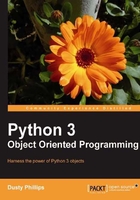
Basic inheritance
Technically, every class we create uses inheritance. All Python classes are subclasses of the special class named object. This class provides very little in terms of data and behaviors (those behaviors it does provide are all double-underscore methods intended for internal use only), but it does allow Python to treat all objects in the same way.
If we don't explicitly inherit from a different class, our classes will automatically inherit from object. However, we can openly state that our class derives from object using the following syntax:
class MySubClass(object):
pass
This is inheritance! This example is, technically, no different from our very first example in Chapter 2, since Python 3 automatically inherits from object if we don't explicitly provide a different superclass. A superclass, or parent class, is a class that is being inherited from. A subclass is a class that is inheriting from a superclass. In this case, the superclass is object, and MySubClass is the subclass. A subclass is also said to be derived from its parent class or that the subclass extends the parent.
As you've probably figured out from the example, inheritance requires a minimal amount of extra syntax over a basic class definition. Simply include the name of the parent class inside a pair of parentheses after the class name, but before the colon terminating the class definition. This is all we have to do to tell Python that the new class should be derived from the given superclass.
How do we apply inheritance in practice? The simplest and most obvious use of inheritance is to add functionality to an existing class. Let's start with a simple contact manager that tracks the name and e-mail address of several people. The contact class is responsible for maintaining a list of all contacts in a class variable, and for initializing the name and address, in this simple class:
class Contact: all_contacts = [] def __init__(self, name, email): self.name = name self.email = email Contact.all_contacts.append(self)
This example introduces us to class variables. The all_contacts list, because it is part of the class definition, is actually shared by all instances of this class. This means that there is only one Contact.all_contacts list, and if we call self.all_contacts on any one object, it will refer to that single list. The code in the initializer ensures that whenever we create a new contact, the list will automatically have the new object added. Be careful with this syntax, for if you ever set the variable using self.all_contacts, you will actually be creating a new instance variable on the object; the class variable will still be unchanged and accessible as Contact.all_contacts.
This is a very simple class that allows us to track a couple pieces of data about our contacts. But what if some of our contacts are also suppliers that we need to order supplies from? We could add an order method to the Contact class, but that would allow people to accidentally order things from contacts who are customers or family friends. Instead, let's create a new Supplier class that acts like a Contact, but has an additional order method:
class Supplier(Contact):
def order(self, order):
print("If this were a real system we would send "
"{} order to {}".format(order, self.name))
Now, if we test this class in our trusty interpreter, we see that all contacts, including suppliers, accept a name and e-mail address in their __init__, but only suppliers have a functional order method:
>>> c = Contact("Some Body", "somebody@example.net") >>> s = Supplier("Sup Plier", "supplier@example.net") >>> print(c.name, c.email, s.name, s.email) Some Body somebody@example.net Sup Plier supplier@example.net >>> c.all_contacts [<__main__.Contact object at 0xb7375ecc>, <__main__.Supplier object at 0xb7375f8c>] >>> c.order("Ineed pliers") Traceback (most recent call last): File "<stdin>", line 1, in <module> AttributeError: 'Contact' object has no attribute 'order' >>> s.order("I need pliers") If this were a real system we would send I need pliers order to Supplier >>>
So now our Supplier class can do everything a Contact can do (including adding itself to the list of all_contacts) and all the special things it needs to handle as a supplier. This is the beauty of inheritance.